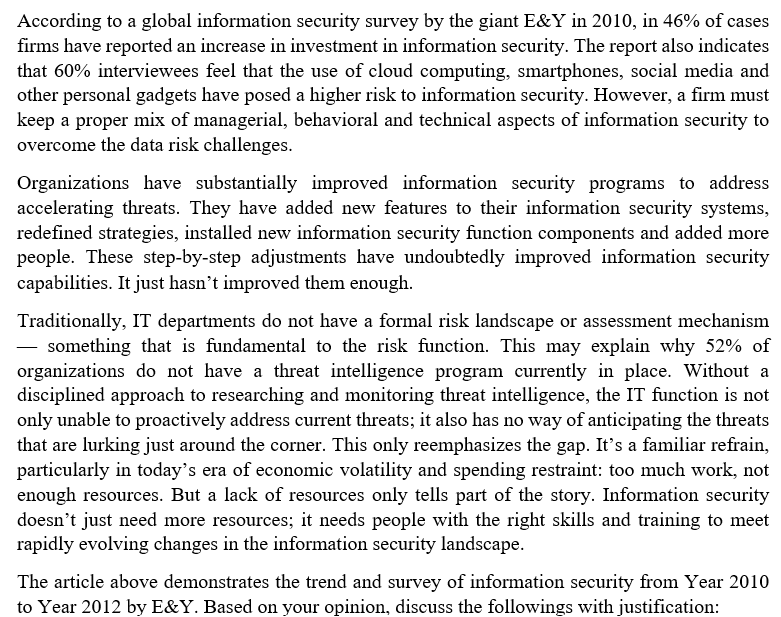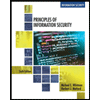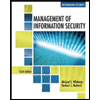With blending IT expertise with a non-IT perspective, how can the organizations enhance overall information security effectiveness?
With blending IT expertise with a non-IT perspective, how can the organizations enhance overall information security effectiveness?
Principles of Information Security (MindTap Course List)
6th Edition
ISBN:9781337102063
Author:Michael E. Whitman, Herbert J. Mattord
Publisher:Michael E. Whitman, Herbert J. Mattord
Chapter11: Security And Personnel
Section: Chapter Questions
Problem 4RQ
Related questions
Question
Need answer. Thank you.

Transcribed Image Text:With blending IT expertise with a non-IT perspective, how can the organizations enhance
overall information security effectiveness?

Transcribed Image Text:According to a global information security survey by the giant E&Y in 2010, in 46% of cases
firms have reported an increase in investment in information security. The report also indicates
that 60% interviewees feel that the use of cloud computing, smartphones, social media and
other personal gadgets have posed a higher risk to information security. However, a firm must
keep a proper mix of managerial, behavioral and technical aspects of information security to
overcome the data risk challenges.
Organizations have substantially improved information security programs to address
accelerating threats. They have added new features to their information security systems,
redefined strategies, installed new information security function components and added more
people. These step-by-step adjustments have undoubtedly improved information security
capabilities. It just hasn't improved them enough.
Traditionally, IT departments do not have a formal risk landscape or assessment mechanism
something that is fundamental to the risk function. This may explain why 52% of
organizations do not have a threat intelligence program currently in place. Without a
disciplined approach to researching and monitoring threat intelligence, the IT function is not
only unable to proactively address current threats; it also has no way of anticipating the threats
that are lurking just around the corner. This only reemphasizes the gap. It's a familiar refrain,
particularly in today's era of economic volatility and spending restraint: too much work, not
enough resources. But a lack of resources only tells part of the story. Information security
doesn't just need more resources; it needs people with the right skills and training to meet
rapidly evolving changes in the information security landscape.
The article above demonstrates the trend and survey of information security from Year 2010
to Year 2012 by E&Y. Based on your opinion, discuss the followings with justification:
Expert Solution
This question has been solved!
Explore an expertly crafted, step-by-step solution for a thorough understanding of key concepts.
Step by step
Solved in 4 steps

Knowledge Booster
Learn more about
Need a deep-dive on the concept behind this application? Look no further. Learn more about this topic, computer-science and related others by exploring similar questions and additional content below.Recommended textbooks for you

Principles of Information Security (MindTap Cours…
Computer Science
ISBN:
9781337102063
Author:
Michael E. Whitman, Herbert J. Mattord
Publisher:
Cengage Learning

Management Of Information Security
Computer Science
ISBN:
9781337405713
Author:
WHITMAN, Michael.
Publisher:
Cengage Learning,

Principles of Information Systems (MindTap Course…
Computer Science
ISBN:
9781305971776
Author:
Ralph Stair, George Reynolds
Publisher:
Cengage Learning

Principles of Information Security (MindTap Cours…
Computer Science
ISBN:
9781337102063
Author:
Michael E. Whitman, Herbert J. Mattord
Publisher:
Cengage Learning

Management Of Information Security
Computer Science
ISBN:
9781337405713
Author:
WHITMAN, Michael.
Publisher:
Cengage Learning,

Principles of Information Systems (MindTap Course…
Computer Science
ISBN:
9781305971776
Author:
Ralph Stair, George Reynolds
Publisher:
Cengage Learning

Principles of Information Systems (MindTap Course…
Computer Science
ISBN:
9781285867168
Author:
Ralph Stair, George Reynolds
Publisher:
Cengage Learning

Fundamentals of Information Systems
Computer Science
ISBN:
9781305082168
Author:
Ralph Stair, George Reynolds
Publisher:
Cengage Learning

Fundamentals of Information Systems
Computer Science
ISBN:
9781337097536
Author:
Ralph Stair, George Reynolds
Publisher:
Cengage Learning